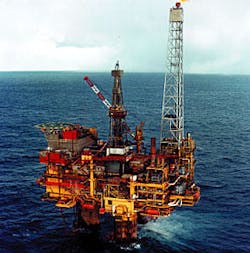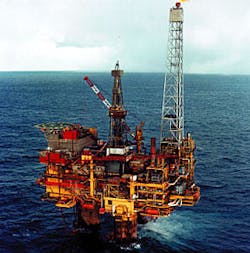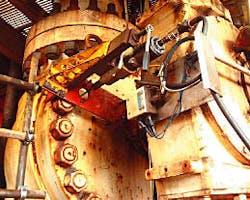O-ring modification on North Sea platform cuts time, expense
Shell UK Exploration and Production, London, saved time and money last year when Furmanite International modified and strengthened an O-ring configuration on an offshore platform in less than 24 hr.
Shell Expro operates in the UK sector of the North Sea on behalf of Shell and Esso. Furmanite International, Aberdeen, is an engineering maintenance and service com- pany.
Furmanite strengthened the O-ring of two 36-in. pipeline internal-gauge (pig) launcher valves on Shell Expro's Bravo platform in the North Sea's Brent field, about 250 miles north of Aberdeen.
Platform closings
The operation required shutting down an export pipeline at the Brent Bravo platform and two adjoining platforms, Brent Charlie and Brent Delta, for about 20 hr. Shell kept a fourth platform, Brent Alpha, fully functional for the 24-hr duration with gas from only this platform.
Completing the job in a single day was crucial, says Furmanite Managing Director Ivor Roberts, because Alpha, Charlie, and Delta platforms were reduced to minimum production during the repair period but could only operate this way for 24 hr.
A gas crossover valve on the Bravo platform was installed in 1990 to isolate incoming gas from the Brent Charlie and Brent Delta platforms. During commissioning of the valve, the lip seal between the valve body and the bonnet failed to hold pressure as prescribed; therefore an O-ring was installed.
Predictive studies later indicated the effects of depressurization that follow planned or unplanned shutdowns would damage the O-ring.
With traditional repair methods, the two valves on the Brent Bravo platform would have been replaced or completely stripped down, overhauled, tested, and certified-all while the export pipeline used by all of the platforms would have to be offline for as long as 10 to 15 days. It would also have required the complete shutdown of the Brent interfield gas system, says Roberts, costing Shell Expro millions in production losses.
Instead, Shell Expro turned to Furmanite to inject sealant into the O-ring cavity to strengthen it. Taking this approach, Furmanite trimmed at least 9 days from the project.
Sealant
Before beginning the project, Furmanite conducted workshop trials on a mock-up of the valves, using a 40-ft refrigerated truck and a 48-hr chill-down accurately to simulate weather conditions expected on the Bravo platform. This scenario provided a full-scale timed trial, allowing engineers to determine that the required results could be achieved and how quickly the job could be completed.
Such workshop trials are common at Furmanite, says Roberts, when the company undertakes critical operations on high-valve or safety-critical installations.
Because most the 24-hr period was required to depressurize and pressurize the pipeline, Furmanite developed a special sealant that cures in 4 hr, rather than the usual 12-16 hr. For this job, the company also developed a custom clamping arrangement and jig piece-a template to control the location of the drilling process.
At the platform, the initial phase involved drilling down about 10 in. through the valve bonnet to hit the O-ring cavity location precisely but leaving some material to break through. The next, lengthy step was to decompress the export pipeline, bringing it down to atmospheric pressure.
Then technicians broke through the remaining metal into the O-ring cavity, injecting the special sealant and allowing it to cure. The sealant had to set quickly but not before circulating completely around the O-ring retaining groove.
Roberts says that 4 hr later-only a quarter of the typical cure time-technicians administered a pressure test, and the pipeline was restored to operating pressure. Furmanite's sealant ensured no decompression in the O-ring.


